Welcome back to Late Talkers Part Two with guest speaker, Abbie Lande! Today we get into the topic of therapy with late talkers. Tune in to hear all about Abbie’s recommended therapy strategies for late talkers and activities to use within speech therapy sessions.
Therapy Strategies for Late Talkers:
Keep it play-based!
- Builds positive adult-child interactions
- Increases participation, motivation, engagement when playing with items of interest
- More functional and natural
- Make more connections with real-life events
- Learn social skills
*Follow child’s lead for more successful therapy
- Model shorter utterances
- Sign language (i.e.; more, help, mine, all done, open, water, milk, play, etc.) – show them how powerful communication can be and they will be more motivated to verbally express wants/ideas
- Self-talk (talk about what YOU are doing) – go on a walk, talk about what you see
- Parallel talk (talk about what your CHILD is doing)
- Singing, and pair it with self/parallel talk
- Communication temptations
- Withhold
- Don’t anticipate the child’s wants/needs
- Expansions
- Receptive language
- WAIT time!
- Fill-in-the-blank
- READ. One of the best things to build speech, language, reading skills is to read with your child!
Augmentative/Alternative Communication (AAC)
- Any form of communication that is not spoken words
- Allows communication
- Reduces frustration (and tantrums!)
- Increases engagement
- Allows for language development to happen before spoken words
- Does NOT prevent a child from speaking – learn the power of communication through AAC
- Types: sign, device, picture exchange, low-tech
EXAMPLE: Abbie introduces a simple sign with almost all her late talkers to let them have a form of communication. Signs: more, help, all done, mine, milk, open, go
Abbie’s Favorite Activities in-person:
- Bubbles
- *Balloon pump (activities that require asking for assistance)
- Melissa and Doug wooden doorbell house and four doors with keys
- Farmhouse with farm animals
- Mr. Potato Head
- Music – super simple songs, instruments, nursery rhymes
- *Stacking blocks
- *Pull-back cars
- *Spin Again Stacking Rings – repetition
- *BOOKS (Vooks)
- iPad games (peek-a-boo farm)
* virtual activities
Real Examples of Current Clients:
Abbie will also be sharing real examples from her current speech therapy clients.
Links & Resources
- The Digital SLP Membership
- Do Late Talkers Grow Out of It?
- Late Talkers – What We Know, and What We Don’t…
Full Transcript of Podcast: Late Talkers – Part Two with Abbie Lande
Episode 84: Late Talkers – Part Two with Abbie Lande
Jessica: You're listening to the Speech Space Podcast, a podcast full of tips and resources for SLPs. I'm your host, Jessica Cassity, and this is Episode 84. Hi everyone! I am so excited to bring Abbie Lande back on the show today to continue our talk about late talkers. Before I do that, I did want to mention that this podcast is brought to you by The Digital SLP membership site, which is a site that features time-saving interactive digital resources that are all teletherapy platform-friendly. You can learn more or sign up by going to thedigitalslp.com/digitalslp. Hey Abbie, thank you for joining me again.
Abbie: Hi Jessica. Thanks for having me again.
Jessica: So today we're going to follow up to our last episode and we're going to be talking about therapy strategies for late talkers. So if you missed the last episode, we talked all about late talkers, essentially. And if you want to listen to that, that was Episode 83. So you can find that by going to thedigitalslp.com/podcast. So let's go ahead and dive right in and talk about some therapy strategies for late talkers.
Abbie: Yeah, so I love working with lake talkers. It's one of my favorite populations and my personal therapy style is very play-based. And so I always tell families right from the beginning when working with children who are late talkers, just following the child's lead, always leads to a more successful therapy session. And keeping it play-based builds those interactions with child and parent, and it increases the participation in the sessions and engagement and just makes it all way more functional. So when thinking of those initial strategies for late talkers, things that I have found very successful in sessions include modeling shorter utterances. So for those kids who aren't using any words yet, rather than modeling, you know, two, three word utterances, focusing on those specific words that you're trying to work on with that child, incorporating sign language in sessions, just having that form of communication for the child. It might be easier for them to use those signs at first, just to give them that first means of communication. So you can decrease that frustration level within sessions and at home. And a great strategy that I love to give parents to use is both self-talk and parallel talk. So just talking about everything you are doing all day long. You know, going on a walk with your dog, you're just talking about what you see outside or what your child is doing in the stroller. And a nice thing to pair with that self-talk and parallel talk is singing. So, you know, using fun songs and tunes and talking about what you're doing. So, for example, like with my little one at home, if we're changing her diaper and excuse my voice, but we'll do songs like I am changing your diaper, I am changing your... and then I pause and see if she can fill in that blank. And it's more fun when you're incorporating the music and the songs, because kids are just so much more in tune with music. And another strategy that I think parents come in not fully understanding, and once they start seeing it in therapy sessions, it makes a world of a difference is not anticipating your child's wants and needs. So if the child might be very good at communicating, so they might be pointing to that ball and gesturing for the ball and making sounds, and the parent knows exactly what they want and they hand the child the ball without anticipating them, trying to use that word. So just explaining this to parents and modeling for them, how to try and have that child either make 'ba' sound or try to say the word ball, or use the sign for ball before actually handing them the object is a great strategy to also start with. Cause I think a lot of parents don't realize how often throughout their days they're actually anticipating their child's wants and needs since they might be very good at communicating in general.
Jessica: Yeah. So I think that's such an important point about anticipating your child's needs or not anticipating your child's needs rather. Because I think as parents, we are so in-tune with our children and it can be so easy just to kind of jump ahead to the next step. So I think that's a really great point that you bring up. Are there any other strategies that you can think of?
Abbie: Yeah. So another strategy, especially for those kiddos who come in, maybe with a couple words already, but you're working on trying to expand those utterances is working on expansions. So if they're saying those one-word utterances, like the child's saying more and you're doing bubbles then modeling for them, oh, you want more bubbles, just to give them that expansion is another great strategy to try and increase how many words they're using. And then another strategy is to never forget about that receptive language. So a lot of these sessions, you're so focused on trying to help the child use words and try to express what they're wanting, but you always want to still remember about the receptive language and pointing to objects and following directions and maybe pointing out objects and books, and remembering to break down directions into smaller steps so that they're following along during the sessions.
Jessica: Okay, great. Great. Those are some really great tips. So let's move on to talking about AAC and I think this is a really important one because I will say I've had more experiences than I'd like to admit where either another SLP or parents will tell me, oh, well we're not doing sign because for example, I used to work in private practice. So I would have a parent saying whenever I was encouraging sign or even like a low-tech communication board. Well, the school SLP said no, because they want to focus on using her words. And it was always very challenging for me. You know, I'd have to bite my tongue for a second and come up with, you know, formulate a very diplomatic response there. But I felt like I heard that a lot more than I would expect or want to hear. So I'd love to talk a little bit about AAC and what your thoughts and experiences are with using AAC.
Abbie: So I am very pro-use of AAC and I have also had that experience as well. A lot of families coming in worried about introducing sign because they don't want the child to not talk. And what I've always explained first is when a child comes in, typically they will have difficulty communicating what they're wanting. So if that is the case, first and foremost is trying to find a means of communication because at home they're showing frustrations, they're having difficulty getting their wants and needs across, and they're not using those words yet. So we need to find some means of communication for them to reduce those frustrations and to give them that means of communication so that we can interact more and engage and actually have those great opportunities with the child to then learn how to use those words. And so whether it's teaching sign or whether it's low-tech or picture exchange or use of a device, you know, finding that means to help that child be able to communicate is always great. And I always explain that using these means of communication doesn't mean that the child is not learning how to speak verbally. If anything, it's aiding it because they can see the sign, they hear the word, and there's multiple modalities being used of them, hearing whatever word you're trying to get the child to say. And so using those AAC options is always beneficial for the child and it doesn't prevent the child from speaking and it gives them that power of communication.
Jessica: Absolutely. And I think the word that's so important there is hearing because I think sometimes people will think that we are replacing speech with sign and that's not the case at all. You're always going to be pairing the word with the sign. You're never just going to be doing a sign independently. So your child is hearing the word while they're seeing the sign. It's not ever going to be, you know, you're going to want to use those approaches together. So I think that's something that's really important to throw out there as well.
Abbie: And once those families see that the child starts with just the sign and then eventually does the sign while saying the word, and then the sign fades out. I think that's the moment where the families understand, oh, so that helped him communicate. And now the word is here. So it's very powerful.
Jessica: Yeah, absolutely. So let's talk about some different types of AAC. We talked about signing. What are some other types that you like to use?
Abbie: So it definitely depends on the client. I have some clients that really benefit from picture exchange and sometimes I'll do actual formal, like I have a PECS book or sometimes it's just having pictures of the toys in the session and the child picks that picture and hands it to me. And that's what we do. And after a while, you know, the child hands me the picture of the bubbles and we blow the bubbles, do the signs, say the words and you know, it's a little bit more informal, whereas some kids might actually have that PECS binder and some other types might be a use of a device. So I've had clients in the past who have like a lamp device to be able to communicate wanting things that way, and incorporating that in the sessions or even a low-tech communication board as well. Just finding the best AAC option for each child. And what's going to click for that child.
Jessica: Yeah. I think that's important. You really have to, it's a little bit of trial and error, right? Sometimes to figure out what is going to work the best for that specific child. And it's not going to be the same across the board. Yeah. Okay. So let's go ahead and talk about some activities for working with late talkers. So what are some things that you like to do? And I'd love to hear a little bit, I know you do a lot of virtual therapy, so I'd love to hear a little bit about some of your favorites for in-person and then some of your favorites for virtual. I know they'll probably be a little bit of overlap. But anything since I know a lot of us are virtual still right now, anything virtual I think would be very helpful too.
Abbie: Yeah. So it's funny because I hadn't ever done a virtual session until last year. And when I had my first client who was, you know, under three, the first thing I thought of was, how am I going to do a session with a two-year-old over the computer? And what I have quickly found is the session looks pretty much identical in-person and over virtual. I use almost the exact same materials and the sessions are run relatively the exact same. So I guess I'll start with the materials that I have found that have been best for virtual and in-person. My go-to always is a balloon pump. I've found just a basic balloon and a balloon pump, both virtual and in-person, allows you to work on so many strategies, such as, you know, saying stop or go or more or up, or my turn. There's just so many opportunities. And then the actual, you blow it up and you release it, and it flies in the air. It's like the most exciting thing to these kids. And even on virtual, you know, holding that balloon really close to the camera as it gets bigger and bigger and bigger, and that anticipation and waiting for them to tell that balloon to go, it's the best activity and the easiest activity to throw in your bag as well.
Jessica: Win-win.
Abbie: Yeah, that's always my thought processes. How can I plan the easiest and the quickest, but also make it the most exciting and interactive activities possible for these children. Another really great one for both in-person and over virtual is just basic stacking blocks. And I even use that with like cars or those pullback cars. So, you know, creating a big tower with the stacking blocks and saying, boom, every time you place it up, up up, every time you place them down or more, and watching that tower get really, really tall and then finally get that pullback car, and then you can tell the car to go or crash or vroom that has been great, both over virtual and in-person, especially on virtual with, you can bring that camera closer to the tower and it just looks so tall over the camera. So I think that's very exciting for the kiddos. And then another great one, I always have books in almost every session and I've kind of done books in multiple ways within virtual sessions, whether I'm holding up the book or I find a book that I can share the screen with and either works. And so books have just been great for just vocabulary and the receptive language and identifying pictures. While also, you know, fill in the blank is another great opportunity with reading books. And my go-to with books is books of song books. So finding those old McDonald or Twinkle, Twinkle Little Star within a book so that you can incorporate that fill in the blank strategy where you leave off that last word of the sentence and the child fills in that blank. So I'm always on the hunt for song books.
Jessica: Yeah. Yeah, and you find that reading the actual book or sharing your screen, you feel like they're equally engaging for your clients? Okay. That's great.
Abbie: Yeah, and it always just depends on the book. Like if I have a book with, you know, the flaps that you open, usually I'll hold up a book over virtual, or if there's like an interactive book that I find online that I can share, just kind of depends on the book that I find. But yeah, I've found both to be very beneficial within virtual sessions.
Jessica: Great. Let's see. Are there any other activities that you have found to be really effective for late talkers?
Abbie: Yeah. So one and there's many activities out there that work for this strategy, but one thing is trying to find an activity where it provides multiple repetitive opportunities for a child to try and say the same word. So for example, one toy that I use a lot is the... that Melissa & Doug like wooden doorbell house. There's just four sides to the house and there's keys that open each door and each door has a different doorbell sound, and it just allows or I'll hide things in each door. And we work on whether it's open or my turn or help because a lot of the kids have trouble using the keys themselves and we open each door and we find who's hiding, but it gives that opportunity of doing that same thing multiple times. So trying to find toys like that, I have always loved incorporating those with this population and also toys where the child has to ask for help. So whatever toy you pick, whether it's Mr. Potato Head or trains or blocks, putting that in a container where the child cannot open, or if you're on virtual and you're shaking the box in front of the camera, waiting for them to tell you, I want it to open, finding toys that they need to ask for assistance is always a great strategy to help with this population as well.
Jessica: Yeah. Yeah. That's great. And I feel like you might have a little bit of an advantage in that specific situation with opening of the box, because I know in-person before you'll have the kids who are like, all right, you're not going to open, I'm just going to open it. But whenever you have the screen between you, you can just hold it there like...
Abbie: Very true. I've had in-person sessions who have figured out the hardest opening boxes or toys, and I'm like, oh man, I waited them out for like a solid minute and now they got it on their own, which is good for them but I was hoping to get that word, but yeah, very true. In virtual they can't open it themselves, so they have to communicate.
Jessica: Yeah. Yeah. Okay. So I know that you mentioned before, you know, whenever you were planning your first virtual session for a little one that you weren't really sure where to start. So why don't we go through and talk about, you know, an example of what a session might look like if in case there's any SLPs listening who are going to be having a teletherapy session with a late talker and might not know where to start.
Abbie: Yeah. So in the very beginning of the sessions, I always check in with the parents. And I want to make sure that the child is in a good spot in the house – not too distracted, TVs are off in the background, and all the toys are put away unless we're going to be using certain toys within the session. So I always just kind of do a quick check-in and see kind of what's going on. And usually within those teletherapy sessions, I'll pull up two different toys and hold them up and have the child point and pick which toy they want to do first. And a lot of the sessions, there's a lot of help from the parents. So I can kind of tell now, you know, if a child is looking towards a certain toy on the camera, I can figure it out without the parents saying, oh, he's pointing to the trains or the bubbles. But giving the child options to pick what they want, cause we always want to remember to follow the child's lead. So if you just choose all the activities and start, the child might not be interested in that activity. So same, same as within an in-person session, if you're following their lead, giving them that opportunity in a virtual session to choose what they're wanting to play with first. And in a typical session, I might grab some bubbles or maybe those balloons, something for pretend play, maybe like a farmhouse and a book always. And you know, let's say we're doing the bubbles and just picking words that we're working on or concepts that we're working on. So, you know, holding those bubbles up and having them ask for open and taking that wand out and working on things like pop or more or ready-set-go. And if we're working on signs, you know, always making sure that the parent knows what the sign looks like and how it's going to work within the interaction. And, you know, if the parent needs to show them first also and take their hands and help them the first time to get those hands together for more, coaching parents through that. But typically my sessions will do about three or four different activities just depending on the client. And I'm always just trying to follow the child's lead and incorporating whether it's using those verbal utterances or the AAC. So if it's signs or a picture exchange, and I always end my sessions with a song at the end. I let the child choose what song they want to do at the end. And yeah, that's kind of, and they're quick and fun and they feel just like in-person sessions. So everything I was always scared of, it's fun and easy and still feels like the in-person therapy that we have always done.
Jessica: Yeah. Yeah. And I love that you end with a song as well, because that's a nice way to wrap up the session where they kind of know what's coming next, which is the end of the session. And it's also a nice rhythm to get into as well. So I love that. Do you have any examples of some of the current clients that you're working with that you'd like to talk about and share a little bit about with our listeners?
Abbie: Yeah, so I know I talked a lot about following the child's lead, and that's just like a big thing that I've noticed with almost every kid on my caseload. It always leads to a more successful session. So off the bat, I'm just thinking very recently, I had a session where a child played with the wooden stacking train toy, the entire session. And you know, me, I had this whole plan, I had all these toys picked out and, you know, halfway through the session, I'm like, oh, I feel like we need to switch it up and pick a different toy. But I just kept saying, let's just keep going and follow his lead and just see where it goes. And it was the best session we've ever had. You know, I was able to get into the interaction with him, build upon his ideas and he would go with the ideas I brought and he would change it up. And then I would join into his idea. And, you know, I had explained to mom, I know this looks kind of weird. We're just playing with one toy the whole time, but look at everything he's done throughout this session. And it was just really neat to see, and it allowed me to take a step back and just recognize it's okay if all the plans don't happen. It always will lead to a better session if you just kind of follow what they're interested in.
Jessica: Yeah. Yeah. I think that's so important to keep in mind that sometimes our agendas have to be pushed aside, especially if we're seeing success in something else that we didn't have planned if it's successful, then why not go with it even if it's not what we had planned out, right? Yeah.
Abbie: Yeah, and I know another example, I just thought of sometimes both in-person and in-virtual sessions, I've had a lot of kids that just come in with a ton of energy and they're just not in a regulated state. So I've just been working through personally, you know, ways to help these families find ways to regulate these children so that they're able to then interact within the sessions. So I've had some discussions about occupational therapy with these families, or just trying to find activities that'll help these kids, whether it's, you know, heavy work or a swing, or sometimes I'll throw like a big yoga ball into our sessions to incorporate just some movement. And recognizing, I kinda need to pause what I'm doing, help the child become more regulated and then kind of bring them back. Because if they come in just with so much energy and just unable to attend, you know, it's hard to start the session until you get to that regulated state. So that's been a good example for just trying to help with this population for sure.
Jessica: Yeah. And I would imagine that comes up a lot. So I think that's a great, great thing to throw out there. Because I, I would imagine that comes up pretty frequently. Yeah. What what advice would you give if you have a client who checks out, as soon as you introduce the situation that requires them to communicate?
Abbie: This is a tough one. So it definitely depends case to case. You know, you always have to feel when to push them and when to kind of back away so that you don't lose that interaction. And some days with that same client, you might have, you might be able to push them and push them and they're communicating and using words and staying in the interactions. But then the next session they come in and you're like, oh, do you want more? And they just walk away or, you know, I have this like a puzzle mat in my office and a lot of kids will go and just start playing with the puzzle mat because they don't want to continue the interaction. So kind of always gauging when a child walks in or when you log in for a virtual session, what state is the child in? Are we in a good state where I can kind of push and explaining to parents, always, you know, right now I'm probably not going to expect him to use words. I'm just going to model right now and I'm not gonna, you know, expect him to say anything. And that's okay. You know, when you're modeling and modeling over and over, they're hearing it, they're seeing those signs, they're understanding and it's okay not to push. Cause when you do push and it's too much and you lose them, then the session is pretty much over and it's hard to come back from there.
Jessica: Yeah, absolutely. Now let's talk a little bit because I see this a lot where I will see a parent telling their child, say "bye" or say this or say that. So in those situations, you know, how can we be educating the parents on a better alternative rather than telling them what to say?
Abbie: I see that a lot. And I've had a lot of conversations with parents because they'll recognize, or parents will say I listened to a podcast and I heard don't do this and should I not be doing this? So I have conversations about the importance of modeling and you know, I explained to parents, it's okay for you to say, say more every once in a while, that's fine. It's a natural instinct. You know, I do it with my little one constantly. I'll be like, oh, you wanted more say more because I know she can do it. But for kids who are, you know, just starting out and learning how to communicate using these verbal utterances, just modeling what you're wanting them to say is going to be just as powerful. And it won't make them shut down. When a child hears say more, say more, say more and it's hard for them and they have trouble doing it. You know, it takes a lot to explain this to parents that by you just modeling it, it's going to also get them to the place of using these verbal utterances. But you know, I always tell parents don't be hard on yourself. It's okay. If you catch yourself doing it, it's very natural. But just the power of modeling is a great piece of education for these families for sure.
Jessica: Right. Yeah. Yeah. I think modeling is so important because we especially have to keep in mind for the little ones who are coming to therapy. It might not be as simple for them depending on what their diagnosis is, which they might not have one yet because they're so little. They might not be capable of saying what it is that you're asking. So if you're asking them to do something that they can't do yet, you know, that can be frustrating for them. So by modeling, that takes that piece out of it as well.
Abbie: Yeah. And then I explained once your child, you know, they can say open, like they've done it multiple times. If you're in a scenario where your child's just pointing and not saying the word, those are great opportunities for you to say, I know, you know how to say open, let's say open and you know, pushing them a little bit, but yeah. When children are having trouble and they come in and it's very hard for them, modeling is always going to be better.
Jessica: Absolutely. Okay. So is there anything else that you would like to share about late talkers that I didn't touch on?
Abbie: I think just, I mean, this population is just so fun to work with and a lot of it is just parent education and parent coaching and just working with parents because, you know, they don't have the education that we have necessarily where, you know, we've learned all these strategies that we can use and it's almost like innate nature for us of how to help this population. So just coaching parents, showing them, and modeling things that they can try at home. And a big thing that I also love to do within sessions is finding things that are going to be more functional. So if a parent comes in and says, you know, I really want them to say mama or, you know, we have a really hard time with bedtime and, you know, if there's a specific scenario at home trying to take that exact scenario and incorporating that within your sessions, so then it's way more functional for them and it will help them on their day to day basis. That's also a great piece and just communicating with families since a lot of it is just coaching with these, with these parents.
Jessica: Yeah. I think that's great advice. I think functional language, you know, I think as SLPs, that's something that makes us all smile whenever we're working on language that's really functional and not, you know, kind of like counting or, you know, something like that. So I think it's, yeah, it's really important to, at least to start with that because that's where the most meaningful communication is going to happen, right?
Abbie: Yup, exactly.
Jessica: Yeah, yeah, exactly. Okay. All right. Well, thank you so much, Abbie, for taking the time to come on here and chat with me. I think that these tips have been amazing and I know that our listeners are going to find them to be so helpful.
Abbie: Thank you so much for having me. This was so fun.
Jessica: Yeah. We'll have to do it again.
Abbie: Yeah!
Jessica: All right. Bye, Abbie.
Abbie: Bye.
Jessica: Thank you so much for tuning in today. If you want to access the show notes from today's episode, you can go to bit.ly/TSSEP84, or if it's easier, you can head on over to thedigitalslp.com/podcast. Thanks again for tuning in. And I hope that you have a wonderful week.


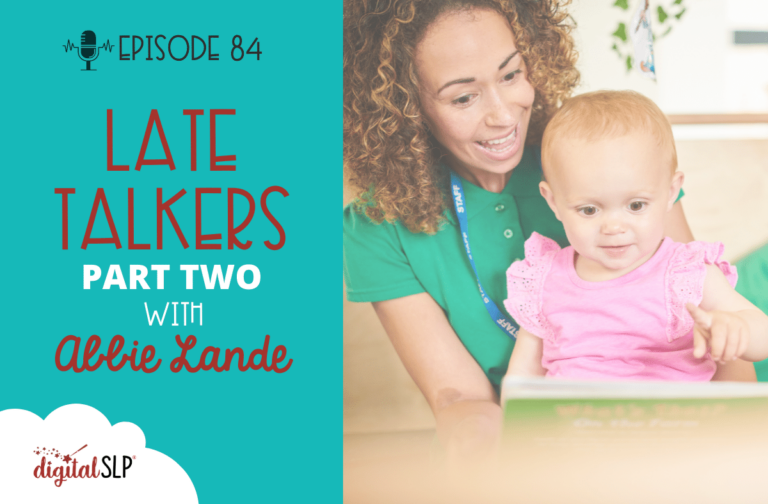



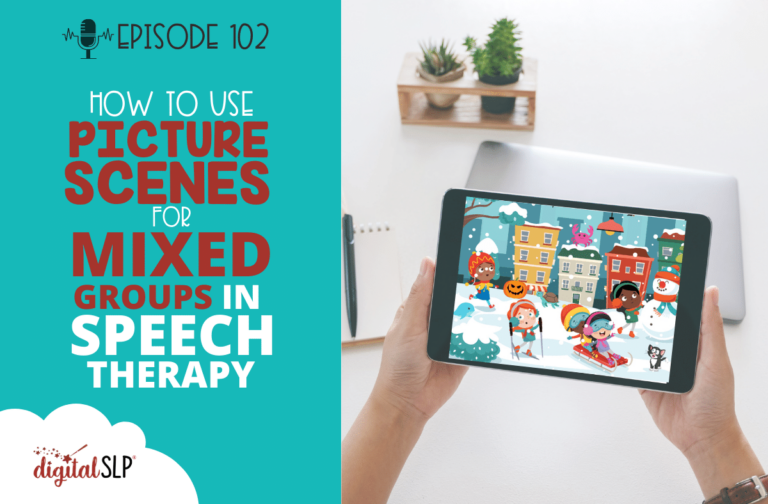
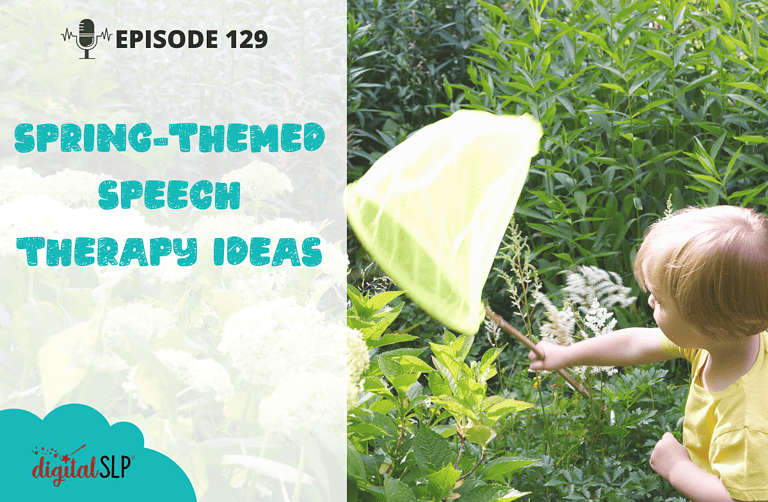
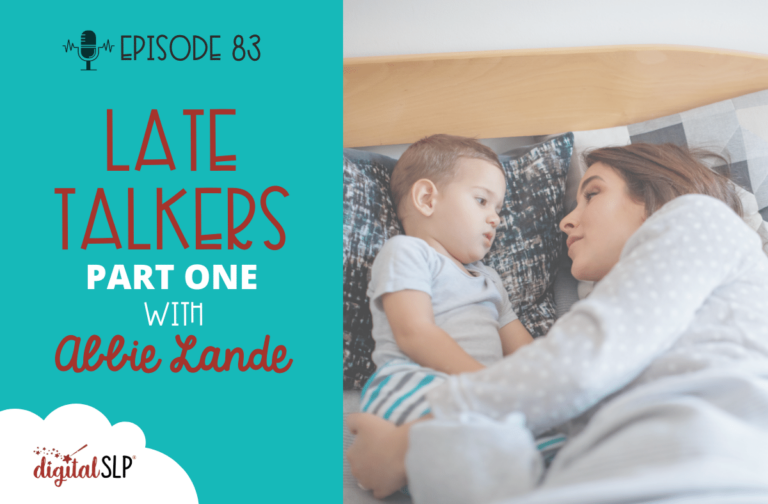
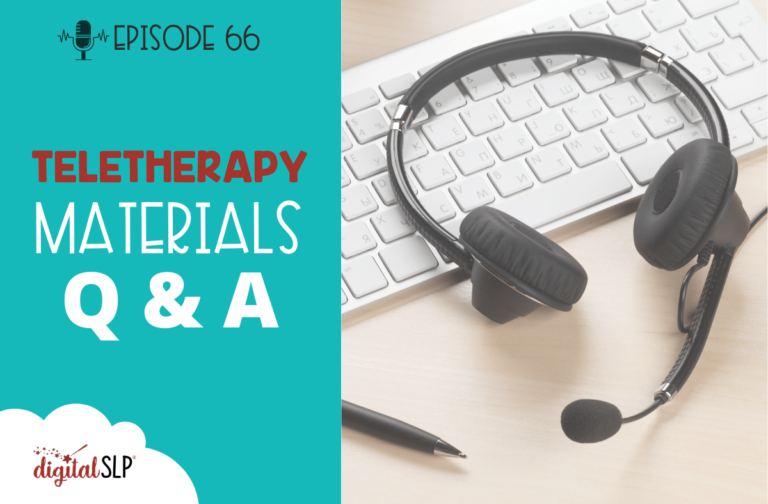
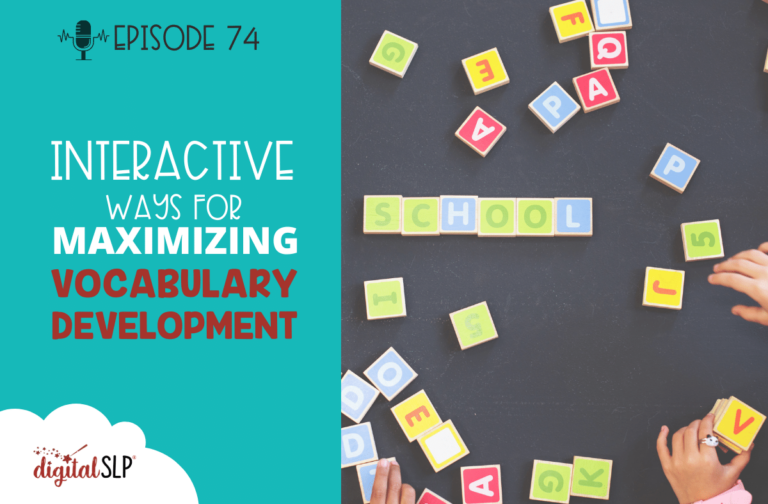
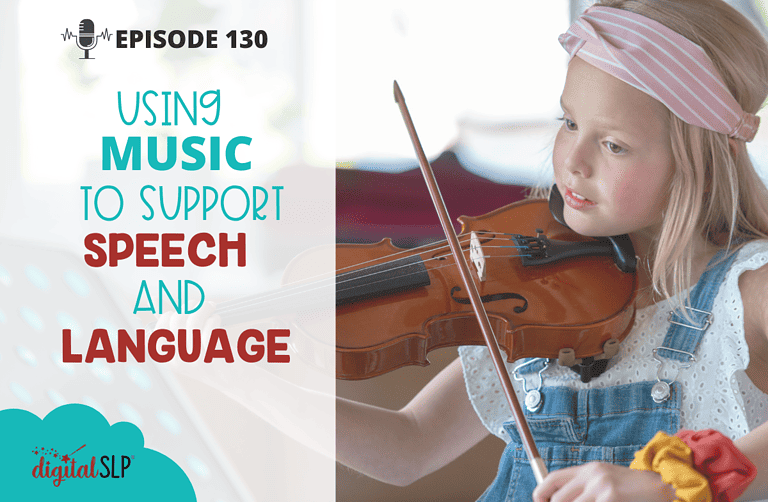

Recent Comments